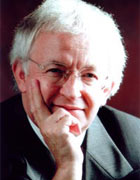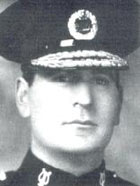2010 Spring Festival - Test piece reviews
12-May-20104BR takes a closer look at the three test pices being used this weekend - from ornate rococo homage and fire breathing dragons to a mass drowning by a spurned princess.
 Rococo Variations (Edward Gregson)
Rococo Variations (Edward Gregson)
On the face of it the title of the latest work – ‘Rococo Variations’ – might suggest some kind of retrenchment back into to creative ‘comfort-zone’ of the 1970s. But titles can be deceptive.
Gregson takes his elegant little theme on a much wider stylistic journey than the themes of his earlier variation works: “I take components of the theme, using them as a quarry for ideas.”
Using the word ‘rococo’ might also suggest that the work was a kind of 18th-century pastiche – a musical decoration in the manner of Tchaikovsky’s famous work for cello and orchestra – rather than something more substantial.
Character
However, it refers to the character of the theme and the way it should be played, not to the working out of the material, which has many fascinating layers to it: elements of the baroque dance suite, of symphonic development and of personal acts of musical homage.
It is by far the most stylistically diverse of all his brass band works – with more in common, not surprisingly perhaps, with the Saxophone Concerto in that regard, than with his youthful band works, where stylistic as well as thematic unity is fundamental.
Six main movements
Gregson has set out to create contrasting musical worlds for each of the six main movements.
The most intriguing element in work for many listeners and players will be musical signatures or references that Gregson has embedded in each movement.
It is by far his most ambitious musical tribute. The keen eared brass band enthusiasts in the Symphony Hall audience on 13th September will have no trouble in picking out references to John McCabe’s ‘Cloudcatcher Fells’, to Wilfred Heaton’s ‘Contest Music’, to Elgar Howarth and Eric Ball. The references to Ray Steadman-Allen and to Philip Wilby may be less obvious.
What I find remarkable about this aspect of the music is the way these references flow in and out of the music in such a natural way – without any sense of contrivance.
This is testimony to the strength of Gregson’s technique and power of his musical imagination of course, especially given that the addition of these musical signatures came quite late on in the compositional process, after the whole piece had been sketched out: “It was simply a matter of choosing the right composer for the music I had already sketched.”
Remarkable piece
'Rococo Variations' was commissioned jointly by the British Open Brass Band Championship and the Norwegian band Federation, with the help of the Co-operative and is dedicated to the composer’s brother Bram.
THEME
A slow, stately pavane-like pulse underpins the simple outlines of the melody and its countersubjects. The composer suggests that this should be played without any indulgent nuance.
Gregson is presenting his ideas that will be developed later: ‘a falling phrase, which outlines the interval of a fifth, is the most obvious element. I also decided to make use of the theme’s sequences a lot as well.’
TOCCATA
This is fast and energetic, with the main theme condensed to its essence – the fifth presented as a chord and them embellished into rising and falling scales in canon.
These stabbing chords and semi-quaver fragments provided Gregson with the obvious place to insert Elgar Howarth’s musical motto – the four note theme that opens ‘Mosaic’ and them appears in many of his later works, most memorably ‘In Memoriam RK’.
SICILIANA
Gregson has employed the gentle compound time lilt of this ancient dance rhythm many times before. This was the first movement to be composed.
The falling fifth idea from the theme becomes the springboard for a wide-ranging solo cornet and euphonium duet, the countersubject of which morphs into a haunting melody from Ray Steadman Allens’s 1957 suite ‘Lord of the Sea’ that was subsequently published as a song with sacred words.
Balancing the accompanimental textures against the solo lines will be crucial here. Incidentally, this work was entered into the same BBC young composers competition, which Howarth won with ‘Mosaic’.
WALTZ
This is pure tongue-in-cheek with, as the composer has said, “…a nod in the direction of the old air varie.”
Eric Ball wrote a number of works of this kind, ‘The Old Wells’, ‘Sound out the Proclamation’ and the middle movement from ‘Tournament for Brass’ being the finest: “Eric did that kind of classical-romantic style very well.”
So it was perhaps inevitable that Gregson should choose this one in which to include an Eric Ball reference. To my ears this movement sounds more like Tchaikovsky than Ball and in the middle it becomes quite sinister with some 12-tone harmonies.
Gregson clearly wanted to say something darker and more questioning – beyond mere pastiche. Originally the movement ended quite differently. The little reference to ‘Journey into Freedom’ on the solo horn – pre-figured by running triplet figures that embellish the reprise of the waltz tune – adds to the air of ambiguity.
MOTO PERPETUO
While the semi-quaver patterns lie pretty comfortably under the fingers here, this movement will provide considerable challenge to all players and conductor.
Gregson is proud of the way he managed to combine the main theme of the whole work and the moto perpetuo ideas in the major key in the middle of the movement:
’For me it’s as though the blazing sun has cast it’s brilliant light onto the proceedings.
Thinking of John McCabe, I realised that my contraction of the falling fifth phrase into a scurrying scale seemed to mirror the way John built his texture in works like 'Images' and ‘Cloudcatcher Fells’, so I gradually worked in my own paraphrase of the main theme from ‘Cloudcatcher’ to provide my final climax.’
LAMENT
This is the most intense and profound movement. Gregson builds it over a repeating bass line, a Chaconne, in which he takes his material about as far away from its original form as he could.
Intervals and harmonies are distorted. The tonality at the beginning is ambiguous, veering between major and minor.
The layers of counterpoint, while not difficult to play, will be a challenge to balance: “What appears to be the main tune on solo cornet, for example, is actually a secondary idea to what is happening below. I’ll be fascinated to hear how everyone handles that.”
There is some relief to the intensity of the first section, with the introduction of a new melody - the nearest Gregson gets to the conventional test-piece cadenza – which is passed around the main soloists and out of which emerges the final elusive ending of the long cornet solo from the middle movement of Heaton’s ‘Contest Music’: “This is my tribute to one of the most original voices in the brass band of the 20th century.”
Typically of Gregson especially in his more recent music, the serenity of the major tonality of the reprise resolves the ambiguity of the opening paragraph in a magical way.
FUGAL SCHERZO
Scherzo might suggest playfulness, but here the virtuoso finale is more ‘diabolical’ in character, at least at the start. It’s not a conventional fugue – there is an accompanying bass line for one thing – but Gregson does employ some fugal techniques.
As it unfolds, he introduces some sinister elements, most especially a 12-tone counter-subject in long notes, giving the music an unsettled character.
This builds into the most technically accomplished few bars in the whole work. Gregson found a way of combining a fragments of his own theme with references to McCabe, Howarth, Heaton and Wilby (from ‘The New Jerusalem’), plus a suggestion of the brilliant fanfare from Monteverdi’s opera ‘Orfeo’, (which is no more than a sequence of scales based on a fifth); all this in the space of eight bars – a real tour-de-force of musical imagination and processing.
Paul Hindmarsh
 The Year of the Dragon (Philip Sparke)
The Year of the Dragon (Philip Sparke)
The highlight of Cory’s centenary celebrations throughout 1984 was a concert held in St. David’s Hall, Cardiff, in March.
The band, with the aid of funds provided by the Welsh Arts Council, commissioned Philip Sparke to write a work for first performance at this concert.
The result was “The Year of the Dragon” of which the composer writes:
“At the time I wrote The Year of the Dragon, Cory had won two successive National Finals and I set out to write a virtuoso piece to display the talents of this remarkable band to the full.” The work is in three movements:
TOCCATA opens with an arresting side drum figure and snatches of themes from various sections of the band, which try to develop until a broad and powerful theme from the middle of the band asserts itself.
A central dance-like section soon gives way to the return of this theme, which subsides until faint echoes of the opening material fade to a close.
INTERLUDE takes the form of a sad and languid solo for trombone. A chorale for the whole band introduces a brief spell of optimism but the trombone solo returns to close the movement quietly.
FINALE is a real tour-de-force for the band with a stream of rapid semi-quavers running throughout the movement. The main theme is heroic and march-like but this is interspersed with lighter, more playful episodes.
A distant fanfare to the sound of bells is introduced and this eventually returns to bring the work to a stirring close.
Philip Sparke
 Le Roi d’Y’s (Eduoard Lalo arranged Frank Wright)
Le Roi d’Y’s (Eduoard Lalo arranged Frank Wright)
As operas go, Edouard Lalo’s, ‘The King of Y’s’ is fairly standard stuff: The usual mix up in the love interest department, revenge, recriminations, remorse, death and destruction on an epic scale. Add in three million gallons of floodwater and you get the picture.
Written in 1875, but revised in 1886, it was first performed two years later to popular, if not critical acclaim. Although the story derives from the Breton legend of the lost city of Y’s (the libretto was written by Edouard Blau), Lalo’s influences are more Germanic – the critics carping that it paid too literal a homage to the influence of Wagner.
Age and contemporary taste has not been kind to it. Despite the popularity of the musical aperitif – “No admittance during the playing of the famous overture,” was a general condition seen on programmes when the work was performed in Paris, the opera has become something of an entertaining, if slightly schizophrenic, curio (it really is a mix of Wagner bombast and fragrant Gounod inspired scented harmonies), perhaps best appreciated after you have got to know Debussy’s later ‘Pelleas et Melisande’.
Mythical city
The story concerns the mythical city of Ys, which is ruled by a King constantly at war with his neighbour. The King has two daughters, both of whom love a Knight called Mylio.
Trouble breaks cover when Mylio picks one nubile princess over the other, resulting in the spurned lass nicking the keys to the dykes that hold back the waters of the Atlantic. With the help of the scheming war mongering neighbour, she opens the floodgates.
With the tsunami about to drown every last soul, she takes stock of what she has just done. Full of remorse as she surveys the flotsam and jetsam rising around her ankles, and armed with a well concealed carving knife, she kills the baddie before throwing herself overboard and to a watery grave.
At that very moment, a kindly spirit (the Patron Saint of Y’s no less) accepts her sacrifice and saves half the city by diverting the waters away from the more well to do areas of real estate (the King’s Palace survives).
Notable melodies
The overture contains many of the more notable melodies to be found in the opera - including the famous aria, ‘Why Suffer in Silence?’ which strangely, is sung by the daughter who gets married and not the one that tops herself. Perhaps marriage to goodie two shoes Mylio wasn’t all that it was cracked up to be.
The equally memorable aria that features earlier in the opera, is also a bit of a portent of things to come - although in keeping with the schizoid nature of the work, Mylio sings, ‘If the sky is full of flames’ – perhaps showing that he didn’t have much foresight of the troubles ahead.
The frantic ‘Presto’ which ends the overture, actually comes earlier in the opera (it is Mylio’s Battle Song) - it would have been much harder to finish an overture with a subterranean flourish, so you can possibly hear why it has survived in better shape than the main work itself.
Exciting if monochrome
The brass band arrangement was made by Frank Wright (right) (one of many overtures that he turned his hand to during the 1960s) and whilst exciting (and has become something of a classic of its type), age has dulled its monochrome edge, even if the basic requirements of good brass ensemble playing remain undimmed by the passing of time.
In keeping with Lalo’s odd take on the story, Wright hands that famous female aria to the euphonium and the male one to the flugel horn – not that too many brass band lovers will complain at that bit of gender bending.
Tremendous energy
As for the ending; Wright wrote in the notes to the National Finals programme: “It is music of tremendous energy, deriving emphasis from prominent, reiterated stretches of triplet groups, quasi trumpets, which pervade the whole score and provide a continuous, vigorous kind of tremolo.”
Try writing that for brass band so its sounds underwater.
‘Le Roi d’Y’s’ was used as the set work for the National Finals at the Royal Albert Hall in 1959, won by a legendary performance by Black Dyke (and Geoffrey Whitham on euphonium) conducted by Major George Willcocks.
It has since become one of the most popular orchestral transcriptions ever made for the brass band medium. Perhaps you can now see why.
Iwan Fox















